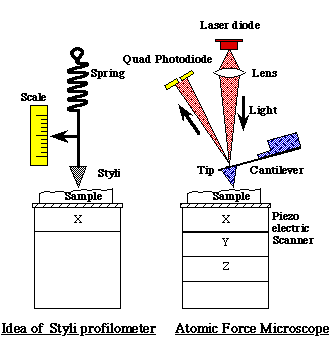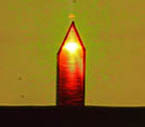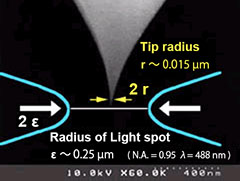Basic idea of AFM
Brief explanation of Atomic Force Microscope (AFM)
An atomic force microscope (AFM) is a new instrument for imaging a sample surface.
As for the structure, an AFM has similarities to a conventional styli profilometer shown in the following illustration, however AFM can reveal a sample surface and precisely up to nanometer size in three dimensions. Due to the sharper tip and small loading force, the lateral resolution in AFM is extremely improved in comparison with the conventional profilometer.
Compare the two !


Following image is a silicon cantilever with the dimension of 160um long and 50um wide, irradiated by red laser beam. The micro cantilever is one of the elements that characterize the AFM system. Stylus profilometer doesn't have such a small mechanical element.
A small protrusion at the end of the cantilever has a sharp apex with the tip-radius of around 5 to 10nm.

As in the picture below, you will see 'super resolution' of AFM. The sharp mechanical protrusion is able to access a smaller area than the focused light spot, beyond diffraction limit of light.
There are two major techniques in AFM. One is DC mode AFM or contact mode AFM, and another is AC mode AFM or dynamic mode AFM.
In DC mode AFM, a tip trace a sample surface with a constant loading force (left illustration).
On the other hand, a tip is vibrated vertically while the scanning in AC mode operation (right illustration).

As a cantilever for DC mode AFM, the cantilever should be soft enough to reduce the loading force as much as possible.
For a cantilever operated in AC mode, different mechanical features are required. The cantilever has a larger spring constant, higher resonance frequency and higher mechanical Q factor (or quality factor) than those of DC mode cantilevers. In these features, high Q factor is important to achieve stable measurement. Like in the right illustration, vibrating a tip at the resonance frequency of a cantilever and approaching the tip to a sample surface, the vibration will change. Using a cantilever with higher Q factor, larger change occurs. This means that higher sensitivity is accomplished in the deflection sensing in an AFM, and that good regulation of a distance between a tip and a sample is expected.
Both in DC and AC mode, lateral resolution depends up on the tip shape. A sharper tip must be used to obtain higher resolution images.
OLYMPUS has insisted on making sharp tips by micro fabrication technique for obtaining fine images.
So now, find the tip for you from the site of OLYMPUS cantilevers.